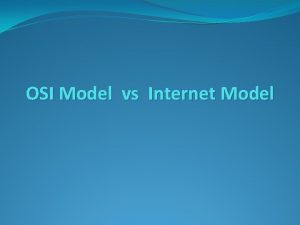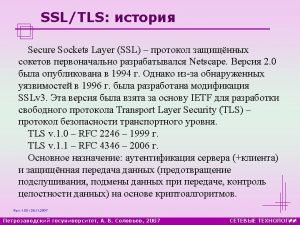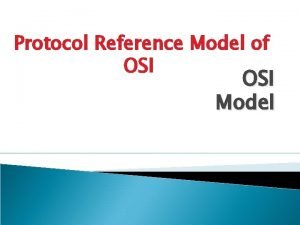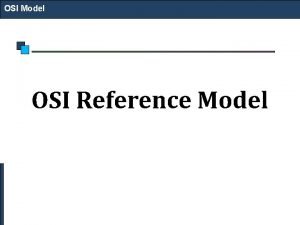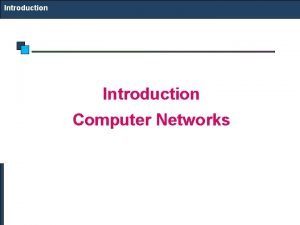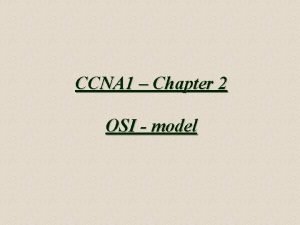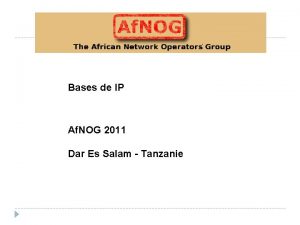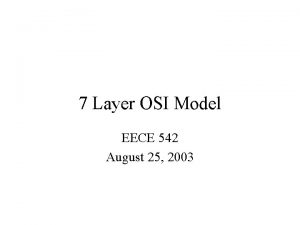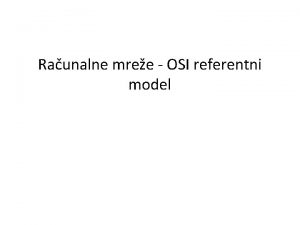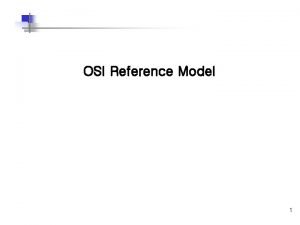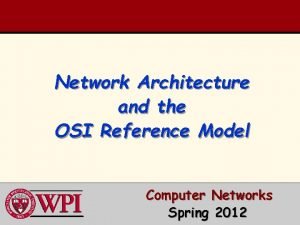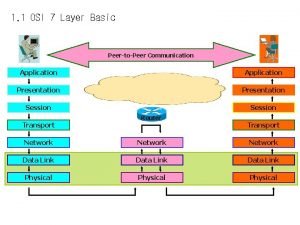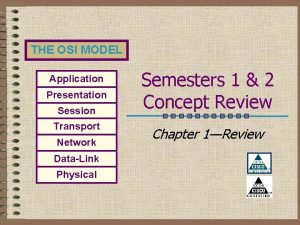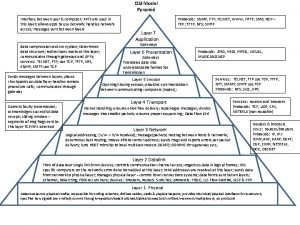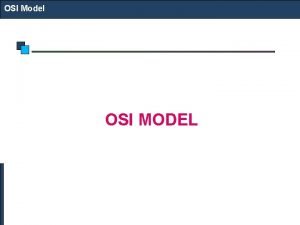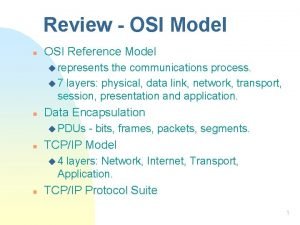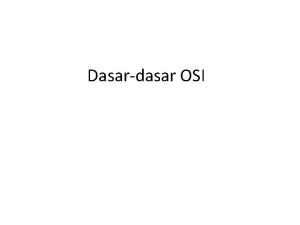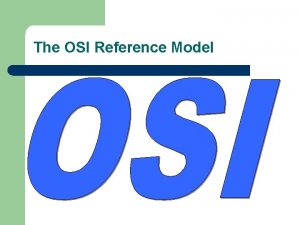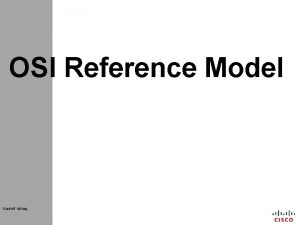The OSI Model 1 The OSI Model An
































- Slides: 32

The OSI Model 1

The OSI Model An ISO (International standard Organization) that covers all aspects of network communications is the Open System Interconnection (OSI) model. An open system is a model that allows any two different systems to communicate regardless of their underlying architecture (hardware or software). The OSI model is not a protocol; it is model for understanding and designing a network architecture that is flexible, robust and interoperable. 2

1. 2. 3. 4. 5. 6. 7. The OSI model is a layered framework for the design of network systems that allows for communication across all types of computer systems. The OSI model is built of seven ordered layers: (layer 1) physical layer (layer 2) data link (layer 3) network layer (layer 4) transport layer (layer 5) session layer (layer 6) presentation layer (layer 7) application layer 3

4

The interaction between layers in the OSI model 5

Physical Layer The physical layer coordinates the functions required to transmit a bit stream over a physical medium. It also defines the procedures and functions that physical devices and interfaces have to perform for transmission occur. The physical layer is responsible for transmitting individual bits from one node to the next. 6

Functions of the physical layer The physical layer is concerned with the following: � Physical characteristics of interfaces and media: The physical layer defines the characteristics of the interface between devices and the transmission media, including its type. � Representation of the bits: the physical layer data consist of a stream of bits without any interpretation. To be transmitted, bits must be encoded into signals –electrical or optical-. The physical layer defines the type of encoding. Is the transmission asynchronous or synchronous? � Data rate: The physical layer defines the transmission rate, the number of bits sent each second. 7

Functions of the physical layer � � � � Line configuration: the physical layer is concerned with the connection of devices to the medium. Signal Encoding How are the bits 0 and 1 to be represented? Transmission type Is the transmission simplex, half duplex or full duplex? Topology what is the topology( Mesh, star, ring, bus or hybrid) used? Multiplexing Is multiplexing used, and if so, what is its type(TDM, FDM)? Interface How are the two closely linked devices connected? Bandwidth Which of base band or broadband communication is being used? Signal type Are analog signals used, or digital? 8

Data Link Layer The data link layer transforms the physical layer, a raw transmission facility, to a reliable link and is responsible for nodeto-node delivery. It makes the physical layer appear error free to the upper layer (network layer). The data link layer is responsible for transmitting frames from one node to the next. 9

Node-to-node delivery 10

Functions of the data link layer � � Framing. The data link layer divides the stream of bits received from the network layer into data units called frames. Physical addressing. If frames are to be distributed to different systems on the network, the data link layer adds a header to the frame to define the physical address of the sender (source address) and/or receiver (destination address) of the frame. If the frame is intended for a system outside the sender’s network, the receiver address is the address of the device that connects one network to the next. Media Access Control(MAC) In LANs, it decides who can send data, when and how much. 11

Functions of the data link layer Addressing Headers and trailers are added, containing the physical address of the adjacent nodes, and removed upon a successful delivery. 12

Functions of the data link layer � � � Flow Control. If the rate at which the data are absorbed by the receiver is less than the rate produced in the sender, the data link layer imposes a flow control mechanism to prevent overwhelming the receiver. Error control. The data link layer adds reliability to the physical layer by adding mechanisms to detect and retransmit damaged or lost frames. Error control is normally achieved through a trailer to the end of the frame. Access Control. When two or more devices are connected to the same link, data link layer protocols are necessary to determine which device has control over the link at any time. 13

Network Layer • The Network layer is responsible for the source-to-destination delivery of a packet possible across multiple networks. • If two systems are connected to the same link, there is usually no need for a network layer. However, if the two systems are attached to different networks, there is often a need for the network layer to accomplish source-to-destination delivery. 14

Functions of the network layer Functions: • Logical addressing Source and destination logical addresses( e. g. IP addresses) • Routing The network layer is responsible for the delivery of packets from the original source to the final destination. 15

Source-to-destination delivery 16

Functions of the network layer Logical addressing. The physical addressing implemented by the data link layer handles the addressing problem locally. The network layer adds a header to the packet coming from the upper layer, among other things, includes the logical address of the sender and receiver. Routing. When independent networks or links are connected together to create an internetwork (a network of networks) or a large network, the connecting devices (called routers or gateways) route or switch the packets to their final destination. 17

18

Transport Layer The transport layer is responsible for process-toprocess delivery of the entire message. The network layer oversees host-to-destination delivery of individual packets, it does not recognize any relationship between those packets. The transport layer ensures that the whole message arrives intact and in order, overseeing both error control and flow control at the process-to-process level. 19

Transport Layer The transport layer is responsible for delivery of a message from one process to another. 20

Reliable process-to-process delivery of a message 21

Functions of the transport layer Port addressing: computer often run several processes (running programs) at the same time. Process-toprocess delivery means delivery from a specific process on one computer to a specific process on the other. The transport layer header include a type of address called port address. The network layer gets each packet to the correct computer; the transport layer gets the entire message to the correct process on that computer. 22

Functions of the transport layer � � Segmentation and reassembly: a message is divided into transmittable segments, each having a sequence number. These numbers enable the transport layer to reassemble the message correctly upon arrival at the destination. Connection control: The transport layer can be either connectionless or connection-oriented. A connectionless transport layer treats each segment as an independent packet and delivers it to the transport layer at the destination machine. A connection-oriented transport layer makes a connection with the transport layer at the destination machine first before delivering the packets. After all the data are transferred, the connection is terminated. 23

Functions of the transport layer � � � Host-to-Host message delivery Ensuring that all the packets of a message sent by a source node arrive at the intended destination. Application-to-application communication The transport layer enables communication between two application running on different computer. Connection The transport layer might create a logical connection between the source and the destination for the duration of the complete message transfer for better control over the message transfer. 24

Functions of the transport layer Flow control: the transport layer performs a flow control end to end. The data link layer performs flow control across a single link. Error control: the transport layer performs error control end to end. The data link layer performs control across a single link. 25

The Session Layer Responsibilities: establishes, manages, and terminates sessions between applications. service location lookup Many protocol suites do not include a session layer. 26

Functions of the session layer � � � The session layer is the network dialog controller. It was designed to establish, maintain, and synchronize the interaction between communicating devices. Sessions and sub-sessions The session layer divides a session into sub-session for avoiding retransmission of entire message by adding checkpoints feature. Synchronization The session layer decides the order in which data need to be passed to the transport layer. Dialog control The session layer decides which user/ application sends data, and at what point of time, and whether the communication is simplex, half duplex or full duplex. Session Closure The session layer ensures that the session between the hosts is closed gracefully. 27

Presentation Layer � The presentation layer was designed to handle the syntax and semantics of the information exchanged between the two systems. It was designed for data translation, encryption, decryption, and compression. � Responsibilities: � data � encryption compression conversion Many protocol suites do not include a Presentation Layer. 28

Functions of the Presentation layer Translation The translation between the sender’s and the receiver’s message formats is done by the presentation layer if the two formats are different. Encryption The presentation layer performs data encryption and decryption for security. Compression For efficient transmission, the presentation layer performs data compression before sending and decompression at destination. 29

Application Layer The application layer enables the user to access the network. It provides user interfaces and support for services such electronic email, remote file access, WWW, and so on. Responsibilities: anything not provided by any of the other layers Issues: application level protocols appropriate selection of “type of service” 30

Functions of the application layer � � � Network Abstraction The application layer provides an abstraction of the underlying network to an end user and an application. File access and transfer It allows a user to access, download or upload files from/ to a remote hosts. Mail services It allows the users to use the mail services. Remote login It allows logging into a host which is remote. World Wide Web (WWW) Accessing the Web pages is also a part of this layer. 31

Application layer The application layer is responsible for providing services to the user. 32
 Osi model vs internet model
Osi model vs internet model Iso/osi
Iso/osi History of osi model
History of osi model Ssl tls osi layer
Ssl tls osi layer Osi network management model
Osi network management model Osi
Osi Osi model
Osi model Osi network management model
Osi network management model Osi network management model
Osi network management model Toptook
Toptook Osi network management model
Osi network management model Iso osi layers
Iso osi layers Encapsulation and decapsulation in osi model
Encapsulation and decapsulation in osi model Which layer of the osi model includes vlans?
Which layer of the osi model includes vlans? X.800 security architecture
X.800 security architecture Osi model ccna
Osi model ccna Osi network management model
Osi network management model Https://ipv4hub.net/
Https://ipv4hub.net/ Osi modell
Osi modell What is osi security architecture
What is osi security architecture Osi model slojevi
Osi model slojevi The basic unit of a physical network (osi layer 1) is the:
The basic unit of a physical network (osi layer 1) is the: Networking osi model
Networking osi model Osi architecture in computer networks
Osi architecture in computer networks Seven layers of the osi model
Seven layers of the osi model Peer-to-peer communication in osi model
Peer-to-peer communication in osi model Osi cunco
Osi cunco Application presentation session
Application presentation session Presentation layer
Presentation layer Osi model
Osi model Osi model nedir
Osi model nedir Osi pyramid
Osi pyramid Osi model architecture
Osi model architecture
